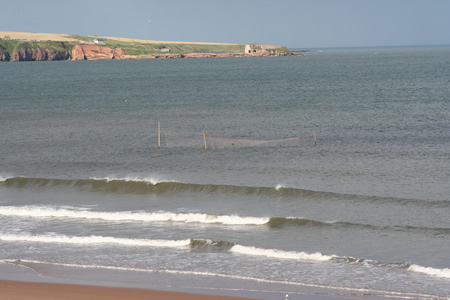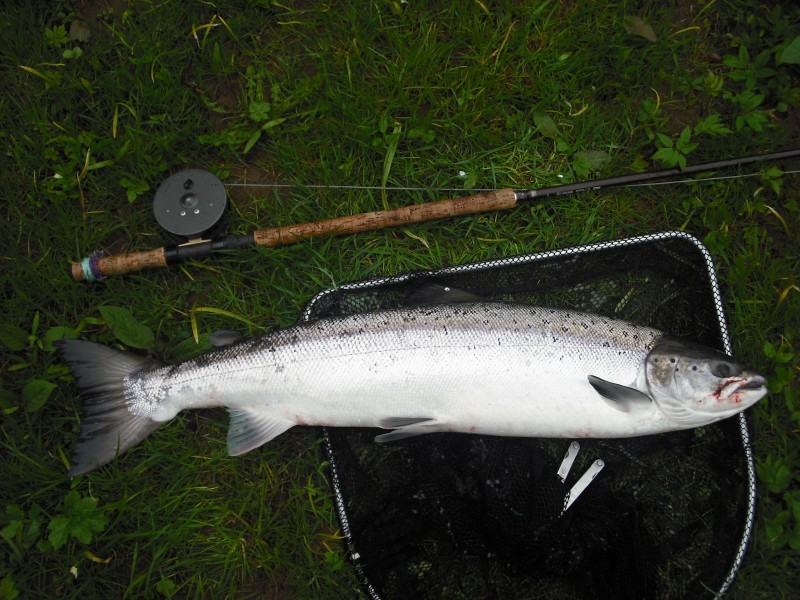These bulletin blogs represent news about Finavon and the South Esk, and my views as a riparian owner. They are not the views of any other organisation, nor are they designed to promote the interests of any individual or organisation other than Finavon Castle Water and factors affecting the fishery. Tony Andrews
South Esk radio-tagging and tracking of spring salmon : a three-year project.
I was wrong in an earlier blog to suggest, on the grounds of cost, that Marine Scotland would be unlikely to use helicopters to track salmon in east coast rivers. They were used to great effect to track tagged salmon in the Don, Dee and the two Esks. None were recorded in either the Bervie or the Earn, which is not to say that tagged fish could not be found in other rivers further away from Usan than those with recorded fish. Smaller rivers such as the Cowie at Stonehaven and the Lunan, near Montrose, have not yet been considered.
Usan Fisheries Ltd nets in Lunan Bay. In May 2011 these nets killed 2,307 spring salmon, of which nearly 700 may have ‘belonged’ to the South Esk and at least 4 other east coast rivers were affected, probably more.
We know from ICES returns that the most fragile component of northeast Atlantic salmon stocks is the spring run of multi sea-winter salmon. Most of the rivers affected by the Usan coastal net catch are showing poor levels of abundance of these early running fish. We should bear in mind that the main spring run is later than it was in the 1970s and 1980s, and now takes place in May. It is from the beginning of that month that the Usan commercial fishery operates. The Usan nets declared a May catch of 2,307 spring salmon in 2011. If you extrapolate that catch proportionately from the 2012 tagging attribution to rivers, it demonstrates the indiscriminate and massively damaging nature of that mixed stocks fishery.
Massive kill of May 2011 spring salmon by Usan nets. Lets do just that, and see what the impact might have been, had the salmon caught by Usan nets in May 2011 been distributed among the rivers proportionately with radio-tagged salmon recorded in Marine Scotland’s 2012 tracking project. Those figures from the 56 salmon recorded after tagging might have revealed the following, had the proportions of that group been attributed to the May 2011 Usan catch of 2,307 MSW salmon:
| River with recorded radio -tagged salmon | Number of 2012 salmon recorded from the 153 tagged | Percentage of 56 salmon recorded(23xSalmon=1%) | No of 2,307 S Usan May 2011 attributed to each river |
| Don | 2 | 3.53% | 80 MSW spring salmon |
| Dee | 8 | 14.12% | 320 ” ” “ |
| North Esk | 19 | 33.53% | 709 ” ” “ |
| South Esk | 18 | 31.77% | 686 ” ” “ |
| Tay | 6 | 10.29% | 240 ” ” “ |
| Recaptured | 3 | 5.29% | 120 ” ” “ |
***The table above comes with a health warning for the following reasons:
- The 2,307 Usan catch return for May 2011 includes all fish caught, and could include fish from rivers other than those listed above.
- The 56 salmon recorded are about 37% of the 153 which were tagged Feb to May 2012.
- Annual variations in abundance, sea conditions and catches give this extrapolation exercise indicative status only. It answers the question “What if the proportions of the Usan May 2011 catch were apportioned to rivers as indicated by the MS 2012 tracking project?”
- However, despite its obvious flaws, there is sufficient hard data behind the figures to suggest that, at the very least, they should reinforce the Precautionary Principle.
Marine Scotland’s South Esk Tracking Project
www.scotland.gov.uk/Topics/marine/science/Research/Freshwater/SoutEskProject
Using data from the first year (of 3 years) of Marine Scotland’s 2012 radio tracking project (153 salmon tagged: 56 later recorded) shows likely exploitation of spring salmon from each river by the Usan Fisheries Ltd coastal nets in May 2011, when 2307 salmon averaging over 9lbs were killed.
In the table above I have taken the percentage of the total salmon recorded after tagging and then attributed those fish on a percentage basis to their rivers. But of course there were only 56 salmon recorded, out of 153 that were fitted with radio tags. However, because of uncertainties over the unrecorded 97 salmon (see paragraph below) it is I feel a valid exercise to use the figure of 56 recorded salmon to allocate the May 2011 catch of 2307 salmon on a proportional basis to each of the affected rivers. Nonetheless, I have also used the bigger number – of tagged salmon, whether recorded or unrecorded – to demonstrate the possible damage done to stocks of spring fish on these rivers, three of which are SACs. Whichever figures you choose to use it is clear that the Usan mixed stocks fishery is doing considerable and indiscriminate damage to fragile spring stocks.
While there may be many reasons for the ‘loss’ of 97 tagged salmon, including predation, regurgitated or malfunctioning tags, or simply that those salmon went out of range or to other rivers, it would perhaps be more logical if we allocate numbers of fish to rivers based on the full 153-fish sample, which generates the figures in the table below:
| River with recorded tagged salmon | Number of salmon recorded | Percentage of fish recorded for each river | Number of May 2011 salmon catch of 2307 attributed to each river |
| Unrecorded | 97 | 63.4% | 1,463 |
| Don | 2 | 1.3% | 35 |
| Dee | 8 | 5.2% | 120 |
| North Esk | 19 | 12.4% | 286 |
| South Esk | 18 | 11.8% | 272 |
| Tay | 6 | 3.9% | 90 |
| Recaptured | 3 | 2.0% | 46 |
“So what?” the cynic might say after reading all these figures, “we’ve known about the mixed stocks nature of Usan nets for years”. Yes, that is certainly true, but I think on this occasion the numbers of fish – a significant proportion of the 153 salmon radio tagged – and the certainty that they are bound for at least 5 other rivers, with the likelihood of other rivers such as Cowie, Lunan and perhaps further afield, show in stark terms the damage that can be done by a mixed stocks fishery at a time when conservation of early running fish is a national management priority. The data have never been more conclusive.
Our cynic might then say, “OK, I concede that point: we now have incontrovertible data showing that these east coast rivers are adversely affected by Usan netting activities, and I don’t deny that is powerful confirmation of what we long suspected. But, judging by its track record, I doubt the Scottish Government will do anything to improve the situation.”
I make the following two points:
The situation has reached a point where the Scottish Government may have to take action in the face of ‘bullet-proof’ data, and because the Westminster Government has now decided to phase out the remaining drift nets and T&J nets by 2022. Moreover, the data are so strong that they may support a successful complaint to Brussels in the light of the 3 SAC rivers (Tay, South Esk & Dee) affected by the Usan nets. Finally, the Minister has not yet responded to the report and recommendations of the Mixed Stocks Fishing Working Group of 2009/10.
The next step is to identify stocks of rivers with fragile populations of spring salmon. If it can be shown that some of the Usan-tagged fish are from populations that are below their conservation levels, then the scientific argument will be watertight when we make the case to the Scottish Government or higher authority for the Usan nets to be closed down. However, even if the angling community argues that catch & release obviates the need to restrict angling pressure on spring salmon, political sensitivities may prevail, with the result that some rivers may have to shorten their angling seasons.
Back to the South Esk;
The tracking project tells us that there are ten tagged fish in the river catchment, representing about 18% of the 56 subsequently recorded radio-tagged fish. Those salmon are well spread out in the main stem and its main tributary, the Prosen. Others will have spawned elsewhere in the system upstream of Finavon. These recorded salmon were caught and tagged in March, April and May, with none from February. The Rottal Burn, recently restored to a more natural meander than a straight drainage ditch, also shows spawning activity, and a visit from one tagged salmon.
TA 18/12/2012


